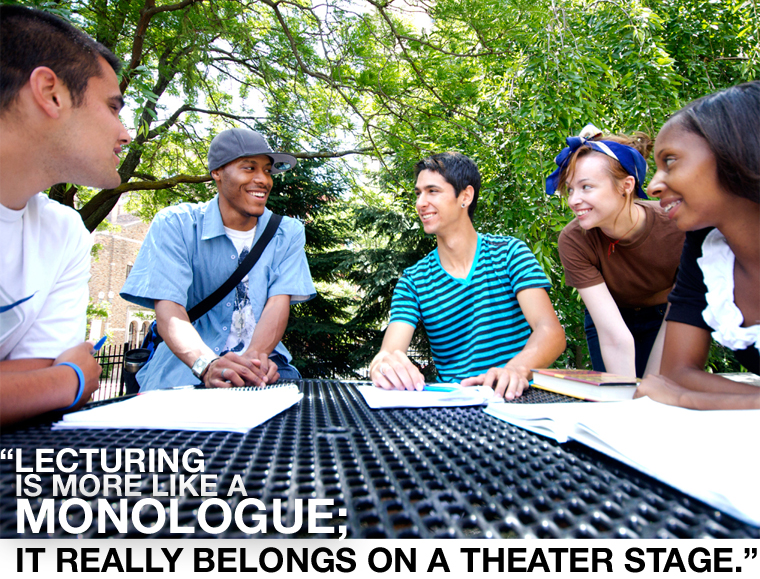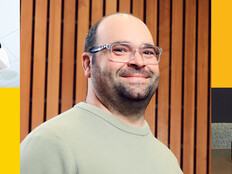How the Hybrid Classroom Found a Home at Grand Rapids
Michigan is well versed in the traditions of higher education. Its flagship schools, the University of Michigan and Michigan State University, deliver top-notch educations, as do its many other public colleges and universities.
But some of the most interesting innovation is happening at a much smaller school. With about 17,000 full-time students, 100-year-old Grand Rapids Community College has embraced an approach to learning, fueled by technology, that is turning standard methodology on its head.

GRCC’s instructional technology team members are the first to say they have no interest in fads. But driving the “flipped classroom” buzz, they found, were some exceptional ideas about using digital tools to shake up traditional pedagogy: By making lectures and learning materials available online, class time can be given over to hands-on teaching and collaborative work.
“It’s a new way to look at teaching, and I think that is what is so inspiring,” says Eric Kunnen, director of distance learning and instructional technologies at GRCC. “The idea is not new, but the technology gives more power, flexibility and opportunity to make use of the limited face-to-face time we have for true student engagement and interactive learning.”
Inside, Outside, All Around
As Kunnen and his colleagues say time and time again, the new way of learning is not about the technology itself; it’s about leveraging technology to produce better learning outcomes, higher student engagement and a more seamless educational experience.
GRCC’s approach is based on the idea that the classroom is everywhere — or rather, the classroom can be everywhere if the necessary elements are in place: content for mobile devices that are supported by a digital learning infrastructure; bring-your-own-device policies for the classroom that are embraced by the faculty; and long-term IT strategies that are funded by a supportive administration.
This approach recognizes the value of hybrid learning. Without forcing any of its faculty to change their methods, GRCC provides the technology and training for anyone who is interested.
All classrooms are equipped with TechSmith Camtasia Relay software that records slideshows and audio. To improve the quality of recorded audio, the school provides wireless lapel microphones. They also have made video cameras available to professors, and Computer Applications Professor Szymon Machajewski has built a Blackboard plug-in for embedding Camtasia Relay videos in the online learning management system.
Such technology not only helps professors flip their classrooms, but also supports online-only classes and virtual office hours.
The Technology Has Arrived
Affordable technology and the trend toward mobility make the timing right for hybrid learning setups. The reaction from students has been overwhelmingly positive, says Kunnen. “The commoditization of technology has helped because students have the devices, and the bandwidth is already in place.”
Associate Professor of Nursing Marie Burns is in her third semester of hybrid teaching and loves what it’s done for her classes. Much of what nursing students learn is functional, and Burns feels that her time is better spent applying concepts to real-life situations. She spends her class time helping students with interview skills, cover letters and board exam preparation.

“I don’t want to be the sage on the stage anymore,” she says. “I want to put that on Camtasia and let my students watch at home, so they come to class prepared. I utilize clicker questions to see what they’ve learned, and I’ve been amazed at what they know when they come into class. We have percentages that are much higher than in the past.”
Says Professor Garry Brand, GRCC’s lead faculty facilitator of distance learning and instructional technologies, in a TechSmith whitepaper: “These days, students who miss an important point the first time have a second chance. After class, they can pipe the lecture to their laptops or MP3 players and hear it again while looking at the slides that illustrate the talk.”
The Good, the Bad and the Future
Some faculty aren’t ready for a hybrid learning environment, but Machajewski is quick to point out that “professors are not going to be replaced by video screens.”
“I’ve heard instructors say, ‘Why are we switching to online delivery? Some students prefer the person-to-person experience,’” Machajewski says. “There is a lot of value in that, but when you are talking to 20 or 30 students at the same time, some of that value is lost.”
Replacing that value by making limited classroom time more useful for students, regardless of how they learn, is a better approach, Machajewski believes. “Lecturing is more like a monologue; it really belongs on a theater stage.”
Whatever the future holds, the instructional technology team is prepared, Kunnen says. “If this is a good way to deliver that instruction, we want to make sure we provide opportunities for our faculty to learn about it. We also want to evaluate it and see how we can extend it over time.”
Learn more about the flipped classroom approach on GRCC’s website and in The Student Demand for Lecture Capture Solutions by TechSmith.








